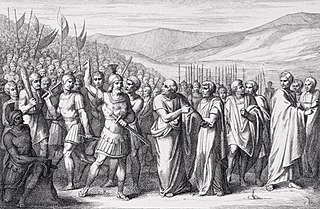Related Research Articles

The Osci were an Italic people of Campania and Latium adiectum during Roman times. They spoke the Oscan language,also spoken by the Samnites of Southern Italy. Although the language of the Samnites was called Oscan,the Samnites were never referred to as Osci,nor were the Osci called Samnites.

Marcus Furius Camillus was a Roman soldier and statesman of the patrician class. According to Livy and Plutarch,Camillus triumphed four times,was five times dictator,and was honoured with the title of Second Founder of Rome.

The First,Second,and Third Samnite Wars were fought between the Roman Republic and the Samnites,who lived on a stretch of the Apennine Mountains south of Rome and north of the Lucanian tribe.
Marcus Valerius Corvus was a military commander and politician from the early-to-middle period of the Roman Republic. During his career he was elected consul six times,first at the unusual age of 23. He was appointed dictator two times and led the armies of the Republic in the First Samnite War. He occupied the curule chair a total of twenty-one times throughout his career. According to tradition,he lived to the age of one hundred.
The gens Sulpicia was one of the most ancient patrician families at ancient Rome,and produced a succession of distinguished men,from the foundation of the Republic to the imperial period. The first member of the gens who obtained the consulship was Servius Sulpicius Camerinus Cornutus,in 500 BC,only nine years after the expulsion of the Tarquins,and the last of the name who appears on the consular list was Sextus Sulpicius Tertullus in AD 158. Although originally patrician,the family also possessed plebeian members,some of whom may have been descended from freedmen of the gens.
Gaius Marcius Rutilus was the first plebeian dictator and censor of ancient Rome,and was consul four times.

Lucius Papirius Cursor was a celebrated politician and general of the early Roman Republic,who was five times consul,three times magister equitum,and twice dictator. He was the most important Roman commander during the Second Samnite War,during which he received three triumphs.
Appius Claudius Crassus InregillensisSabinus was a Roman senator during the early Republic,most notable as the leading member of the ten-man board which drew up the Twelve Tables of Roman law around 451 BC. He is also probably identical with the Appius Claudius who was consul in 471 BC.

The first secessio plebis was a significant event in ancient Roman political and social history that occurred between 495 and 493 BC. It involved a dispute between the patrician ruling class and the plebeian underclass,and was one of a number of secessions by the plebs and part of a broader political conflict known as the conflict of the orders.
Gaius Sulpicius Peticus was a prominent fourth century Roman politician and general who served as consul five times and as dictator once. Sulpicius was a member of the gens Sulpicia,a prominent patrician family which had attained the consular dignity a great number of times since the foundation of the republic. The familial relationship between Sulpicius and other known contemporary members of the gens is unknown however,with the only things known about his heritage being that his father was named Marcus and his grandfather was named Quintus.
Lucius Julius Iullus was a member of the ancient patrician gens Julia. He was one of the consular tribunes of 438 BC,magister equitum in 431,and consul in 430 BC.
Gaius Julius Iullus was a Roman statesman and member of the ancient patrician gens Julia. He was consular tribune in 408 and 405 BC,and censor in 393.
Gaius Julius Iulus was a member of the Roman gens Julia,and was nominated dictator in 352 BC.

Quintus Publilius Philo was a Roman politician who lived during the 4th century BC. His birth date is not provided by extant sources,however,a reasonable estimate is about 365 BC,since he first became consul in 339 BC at a time when consuls could be elected in their twenties. His Greek cognomen ‘Philo’was unique to his family.
Aulus Cornelius Cossus Arvina was a Roman politician and general who served as both consul and Magister Equitum twice,and Dictator once in the mid 4th century BC.
Lucius Lucretius Tricipitinus Flavus was a Roman statesman and general who had a prominent career in the early 4th century BC,serving once as consul,and four times as consular tribune,as well as perhaps serving as Princeps senatus.
Publius Cornelius Arvina was a Roman politician and general who lived in the late 4th century and early 3rd century BC,who served as consul of the Roman Republic twice,and as censor once.
Gaius Poetelius Libo Visolus was a Roman politician and general who lived in the mid-fourth century BC and served multiple times as consul.
Lucius Aemilius Mamercinus was a Roman politician and general who,in the early 4th century BC,held the office of consular tribune an extraordinary six times in his distinguished,yet mostly unknown,career.
Publius Sempronius Sophus was a Roman politician and general who achieved the honors of being both consul and censor in his political career,as well as renown for being a talented and well respected jurist.